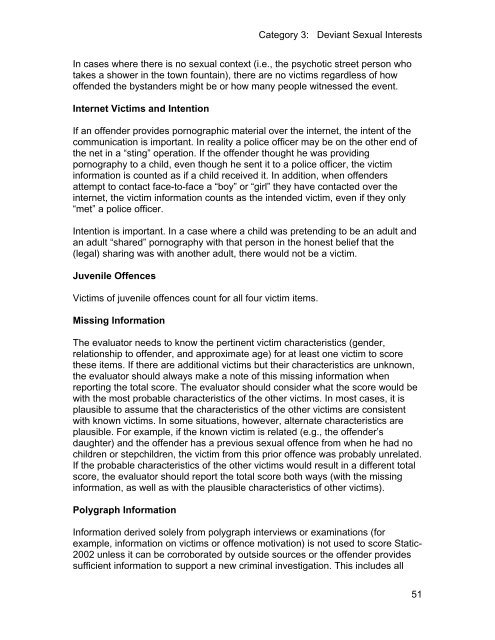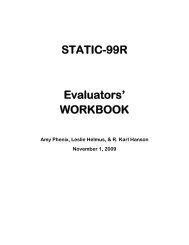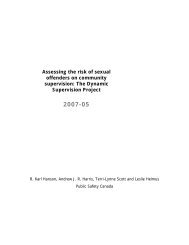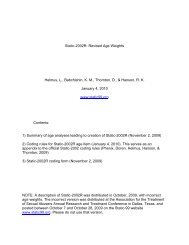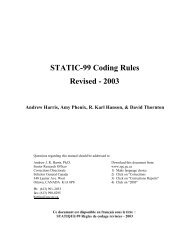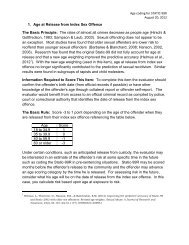Static-2002 coding rules (2009) - Static-99
Static-2002 coding rules (2009) - Static-99
Static-2002 coding rules (2009) - Static-99
Create successful ePaper yourself
Turn your PDF publications into a flip-book with our unique Google optimized e-Paper software.
Category 3: Deviant Sexual Interests<br />
In cases where there is no sexual context (i.e., the psychotic street person who<br />
takes a shower in the town fountain), there are no victims regardless of how<br />
offended the bystanders might be or how many people witnessed the event.<br />
Internet Victims and Intention<br />
If an offender provides pornographic material over the internet, the intent of the<br />
communication is important. In reality a police officer may be on the other end of<br />
the net in a “sting” operation. If the offender thought he was providing<br />
pornography to a child, even though he sent it to a police officer, the victim<br />
information is counted as if a child received it. In addition, when offenders<br />
attempt to contact face-to-face a “boy” or “girl” they have contacted over the<br />
internet, the victim information counts as the intended victim, even if they only<br />
“met” a police officer.<br />
Intention is important. In a case where a child was pretending to be an adult and<br />
an adult “shared” pornography with that person in the honest belief that the<br />
(legal) sharing was with another adult, there would not be a victim.<br />
Juvenile Offences<br />
Victims of juvenile offences count for all four victim items.<br />
Missing Information<br />
The evaluator needs to know the pertinent victim characteristics (gender,<br />
relationship to offender, and approximate age) for at least one victim to score<br />
these items. If there are additional victims but their characteristics are unknown,<br />
the evaluator should always make a note of this missing information when<br />
reporting the total score. The evaluator should consider what the score would be<br />
with the most probable characteristics of the other victims. In most cases, it is<br />
plausible to assume that the characteristics of the other victims are consistent<br />
with known victims. In some situations, however, alternate characteristics are<br />
plausible. For example, if the known victim is related (e.g., the offender’s<br />
daughter) and the offender has a previous sexual offence from when he had no<br />
children or stepchildren, the victim from this prior offence was probably unrelated.<br />
If the probable characteristics of the other victims would result in a different total<br />
score, the evaluator should report the total score both ways (with the missing<br />
information, as well as with the plausible characteristics of other victims).<br />
Polygraph Information<br />
Information derived solely from polygraph interviews or examinations (for<br />
example, information on victims or offence motivation) is not used to score <strong>Static</strong>-<br />
<strong>2002</strong> unless it can be corroborated by outside sources or the offender provides<br />
sufficient information to support a new criminal investigation. This includes all<br />
51


